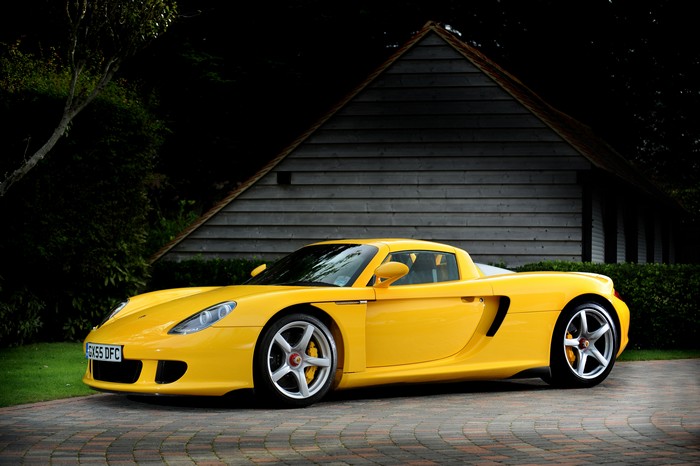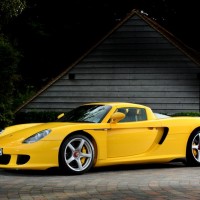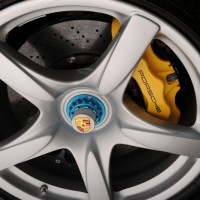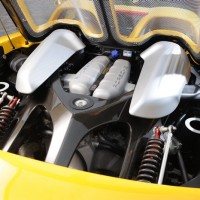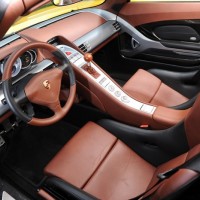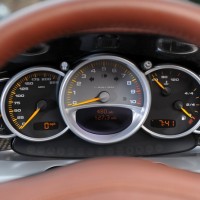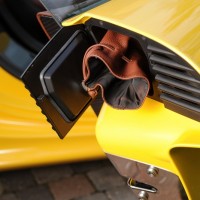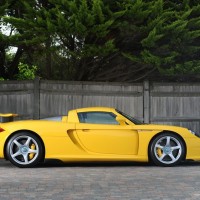When Porsche decided to attach the GT appellation to Carrera in 2004, it marked a return to its competition roots, the new flagship supercar’s looks recalling those of the original Type 550 of 50-plus years ago. Known as “Project Code 80,” the program to develop a front-ranking supercar had begun following Porsche’s Le Mans win with the 911 GT1 in 1998. Although a couple of dozen GT1s were adapted for road use, something more practical would be required for volume production, although it was intended that the GT1’s advanced technology would be carried over to the new model.
The first hint that Porsche was planning something very special was dropped in 2000, when a concept car designed by American Grant Larson appeared on the Stuttgart manufacturer’s stand at the Paris Motor Show.
Porsche employed racing driver Walter Röhrl to assist with development, which included countless laps of the demanding Nürburgring circuit. In the interest of high-speed stability, the rear body incorporates a wing that is raised automatically at around 75 mph, retracting when the speed drops back to 50 mph. This was a vital necessity in a car capable of exceeding 200 mph.
Porsche stated that only 1,500 Carrera GTs would be made, thereby emphasizing the car’s exclusivity, and each example carries a numbered plaque on the center console (the factory retained No.1 for its museum). When deliveries commenced in January 2004, the selling price was $448,000 (approximately £279,500, or $349,200 at current rates of exchange).
SCM Analysis
Detailing
| Vehicle: | 2005 Porsche Carrera GT |
| Number Produced: | Factory reports disagree, but 1,270 is the best supported number |
| Original List Price: | $448,000 |
| Tune Up Cost: | $4,000, including valve adjustment |
| Club Info: | Porsche Club of America |
| Website: | http://www.pca.org |
This car, Lot 355, sold for $452,598, including buyer’s premium, at Bonhams’ Weybridge, U.K., sale on December 3, 2012. That sales price continues the recent trend of stronger prices for this Porsche.
The Carrera GT is Porsche’s third true supercar, following in the footsteps of the 1986 Porsche 959 and the 1998 GT1. Aficionados will argue that there are many Porsche “supercars,” and the point is well taken. But if supercars should be a departure from a manufacturer’s comfort zone, then three is the right count.
The Carrera GT was introduced at the Louvre in September 2000 as a lead-in to the Paris Auto Show. Walter Röhrl took the prototype roadster on a short pre-dawn tour up and down the Champs Elysees before settling in with a host of journalists gathered for the occasion at the Louvre. The car was stunning. It was longer, wider and lower than a production 911, with a carbon fiber tub and a 68-degree 5.5-liter V10 developing 558 DIN horsepower and 442 foot-pounds of torque. That normally-aspirated engine had its origins in an abandoned 1992 Formula One design, the Footwork Porsche.
At the introduction, Porsche’s CEO, Dr. Wendelin Wiedeking, told the story of how the car had been conceived at Le Mans in June 1998 as Porsche’s GT1s were taking 1st and 2nd place overall at the 24-Hour classic. The Carrera GT would use some technology taken from that successful Le Mans race car.
Eighteen months later, in December 1999, Porsche announced that they were abandoning the next Le Mans race-car project to concentrate on development of their SUV, the upcoming Cayenne. Some industry observers also opined that Ferdinand Piech, chairman of the Cayenne co-operative VW Group, might not have looked favorably on in-family competition for his Audi FIA endurance race cars.
Porsche had already assigned the Type 980 Carrera GT project to the now-not-so busy Le Mans engineering team. Porsche used the V10 intended for that race car, along with a host of additional race-car technology, to design the Carrera GT. The design emanated from Porsche’s California studio, with Grant Larson often given primary credit.
From secrecy to a hit
The two roadster prototypes were tested mostly in Nevada, keeping away from auto spy specialists. Thus, the introduction took some observers by surprise. The Paris press showing was to promote buyer interest — and to perhaps assuage Porsche’s sports car devotees dismayed by the already-announced Porsche SUV. Wiedeking explained that the GT would go into production if at least 500 orders were forthcoming by 2003; the price would be between $350,000 and $400,000; the car would be sold in the U.S.; and that the production version would hew very closely to the prototype he was showing in Paris.
Porschefiles waxed poetic. Interest was strong. Buyers lined up. Porsche introduced the production version to the world in March 2003 at the Geneva Auto Show, announcing that they planned to build 1,000 of them — later raised to 1,500 — while unveiling uprated specifications versus the Paris prototype. Displacement was now 5.7 liters; horsepower was up to 612 DIN with 437 foot-pounds of torque. Weight was 3,042 pounds. And performance figures were announced: 0–60 mph in 3.8 seconds and a top speed of 205 mph. It was a real supercar.
Saturated with high technology
Porsche applied for 70 patents related to production of the Carrera GT, many of them for the relatively exotic carbon-fiber monocoque chassis and engine sub-frame, which involved differing compositions in various weaves and weights, sometimes with aluminum or Nomex sandwiched in — and up to 10 layers of material. The chassis and engine sub-frame were built by Italy’s ATR Composites Group, and the technology was presented separately at the Frankfurt Auto Show in 2005. Only the bumpers were old-fashioned fiberglass.
Mechanically, Porsche brought over their PCCB ceramic brakes, just larger. The clutch was a newly designed ceramic and titanium multiple-disc setup, only 6.7 inches in diameter, which was key to the car’s low center of gravity. Magnesium center-lock wheels combined with the ceramic brakes to keep upsprung weight to a minimum. The suspension pieces were forged aluminum and stainless steel. The gas tank was aluminum and located amidships, à la the Auto Union GP racers of the 1930s (a Dr. Ferdinand Porsche design), to maintain steady weight distribution regardless of the fill level. The 6-speed gearbox, with a 30% limited slip, was mounted transversely.
More than 1,200 sold
The Carrera GT started deliveries in early 2004, priced at $448,000 with air conditioning the primary option. Five standard colors were offered: Guards Red, Fayence Yellow, Basalt Black, GT Silver and Seal Grey. Custom colors were also available, and they usually draw a premium price in today’s aftermarket.
Ultimately, Porsche sold about 600 units in the U.S. Car and Driver’s track test achieved better performance results than the Factory claimed: 0–60 mph in 3.5 seconds, 0–100 mph in 6.8 seconds, and the quarter-mile in 11.2 seconds at 136 mph.
Two types of customers bought Carrera GTs: Porsche aficionados and fans of supercars who might already have or aspire to cars such as Ferrari Enzos and McLaren GTs. Some purists were initially resistant, viewing the Carrera GT as a Porsche money-maker that was not a sufficiently imperative purchase. That point of view has fallen by the wayside as the years have passed.
While you could buy almost any Carrera GT you wanted for about $325,000 in 2009, they have now rocketed past $400,000 on their way to regaining MSRP. Several private sales in the U.S. have been in that range, including a Fayence Yellow example in Connecticut with 3,500 miles.
Farewell, depreciation
The Bonhams Weybridge auction example was also Fayence Yellow with an Ascot Brown interior, showing only 480 miles in the hands of one English supercar enthusiast who is acknowledged for properly maintaining his cars. The total, with Bonhams’ buyer’s premium tacked on, of $452,598 was the new market-correct price for this somewhat more desirable color and extremely low mileage. A fair deal on both sides.
Your correspondent believes that the upward trend will continue. Hardcore Porsche collectors who initially passed on Carrera GTs are now reconsidering. The exotic engineering has passed the test of time and is still a high standard for a car that you can drive regularly.
Whether you love it or not, the styling has not been replicated in any other car and is as distinctive now as it was at introduction 12 years ago.
If there is a fly in the ointment, it is the utterly amazing repair expense for the carbon-fiber parts should the unspeakable happen — and inopportune application of the accelerator will get you in a heap of trouble in a hurry. But for skilled drivers with an adult attitude, the Carrera GT is one super ride. ?
(Introductory description courtesy of Bonhams.)
